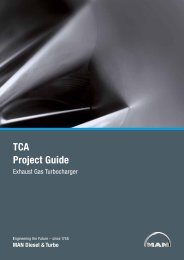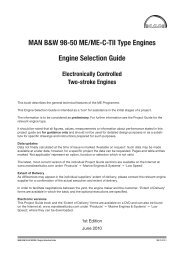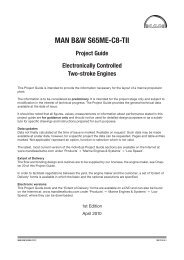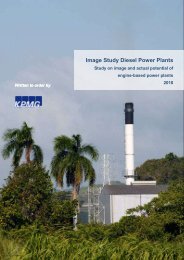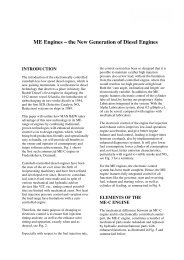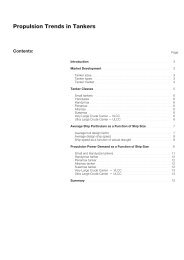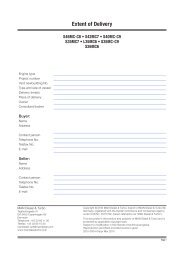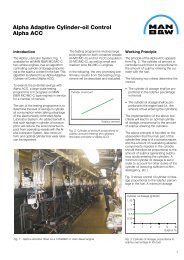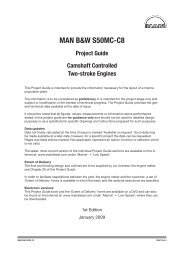Alphatronic Remote Control System - MAN Diesel & Turbo
Alphatronic Remote Control System - MAN Diesel & Turbo
Alphatronic Remote Control System - MAN Diesel & Turbo
Create successful ePaper yourself
Turn your PDF publications into a flip-book with our unique Google optimized e-Paper software.
<strong>Alphatronic</strong> <strong>Remote</strong> <strong>Control</strong> <strong>System</strong><br />
Contents Page<br />
Introduction . . . . . . . . . . . . . . . . . . . . . . . . . . . . . . . . . . . . . . . . . . . . . . . . . . . . . . . 3<br />
Ship’s Propulsion Power – controlled by <strong>Alphatronic</strong> . . . . . . . . . . . . . . . . . 5<br />
Evolution of control . . . . . . . . . . . . . . . . . . . . . . . . . . . . . . . . . . . . . . . . . . . . . . . . . . 5<br />
Accumulated expertise . . . . . . . . . . . . . . . . . . . . . . . . . . . . . . . . . . . . . . . . . . . . . . 5<br />
<strong>Control</strong> is crucial . . . . . . . . . . . . . . . . . . . . . . . . . . . . . . . . . . . . . . . . . . . . . . . . . . . . 6<br />
Inherent advantages . . . . . . . . . . . . . . . . . . . . . . . . . . . . . . . . . . . . . . . . . . . . . . . . 6<br />
The engine and propeller manufacturer’s advantage . . . . . . . . . . . . . . . . . . . . . 6<br />
<strong>Alphatronic</strong> <strong>Remote</strong> <strong>Control</strong> <strong>System</strong> – General . . . . . . . . . . . . . . . . . . . . . . . 7<br />
Plant configurations . . . . . . . . . . . . . . . . . . . . . . . . . . . . . . . . . . . . . . . . . . . . . . . . . 7<br />
Included in the system . . . . . . . . . . . . . . . . . . . . . . . . . . . . . . . . . . . . . . . . . . . . . . . 8<br />
Engine equipment . . . . . . . . . . . . . . . . . . . . . . . . . . . . . . . . . . . . . . . . . . . . . . . . . . 8<br />
Primary control function . . . . . . . . . . . . . . . . . . . . . . . . . . . . . . . . . . . . . . . . . . . . . . 8<br />
In case of emergency . . . . . . . . . . . . . . . . . . . . . . . . . . . . . . . . . . . . . . . . . . . . . . . 8<br />
Load control . . . . . . . . . . . . . . . . . . . . . . . . . . . . . . . . . . . . . . . . . . . . . . . . . . . . . . . . 10<br />
<strong>Control</strong> lever order and command . . . . . . . . . . . . . . . . . . . . . . . . . . . . . . . . . . . . . 12<br />
Load program . . . . . . . . . . . . . . . . . . . . . . . . . . . . . . . . . . . . . . . . . . . . . . . . . . . . . . 13<br />
Manoeuvre Panels . . . . . . . . . . . . . . . . . . . . . . . . . . . . . . . . . . . . . . . . . . . . . . . . . 14<br />
Mode of operation . . . . . . . . . . . . . . . . . . . . . . . . . . . . . . . . . . . . . . . . . . . . . . . . . . 14<br />
Separate mode . . . . . . . . . . . . . . . . . . . . . . . . . . . . . . . . . . . . . . . . . . . . . . . . . . . . . 14<br />
Combined mode . . . . . . . . . . . . . . . . . . . . . . . . . . . . . . . . . . . . . . . . . . . . . . . . . . . . 14<br />
Constant speed mode . . . . . . . . . . . . . . . . . . . . . . . . . . . . . . . . . . . . . . . . . . . . . . . 15<br />
Bridge and bridge wing manoeuvre panels . . . . . . . . . . . . . . . . . . . . . . . . . . . . . 16<br />
Manoeuvre distribution between bridge panels . . . . . . . . . . . . . . . . . . . . . . . . . . 17<br />
Engine control room manoeuvre panel . . . . . . . . . . . . . . . . . . . . . . . . . . . . . . . . . 18<br />
Manoeuvre responsibility panels . . . . . . . . . . . . . . . . . . . . . . . . . . . . . . . . . . . . . . 19<br />
Special Panels . . . . . . . . . . . . . . . . . . . . . . . . . . . . . . . . . . . . . . . . . . . . . . . . . . . . . 20<br />
Shaft alternator panel . . . . . . . . . . . . . . . . . . . . . . . . . . . . . . . . . . . . . . . . . . . . . . . 20<br />
Shaft alternator speed control with Power Management . . . . . . . . . . . . . . . . . . 20<br />
Load limiter panel . . . . . . . . . . . . . . . . . . . . . . . . . . . . . . . . . . . . . . . . . . . . . . . . . . . 21<br />
<strong>Control</strong> and Interface Unit . . . . . . . . . . . . . . . . . . . . . . . . . . . . . . . . . . . . . . . . . . 22<br />
<strong>Alphatronic</strong> control unit . . . . . . . . . . . . . . . . . . . . . . . . . . . . . . . . . . . . . . . . . . . . . . 23<br />
Interface unit . . . . . . . . . . . . . . . . . . . . . . . . . . . . . . . . . . . . . . . . . . . . . . . . . . . . . . . 23<br />
Load program unit . . . . . . . . . . . . . . . . . . . . . . . . . . . . . . . . . . . . . . . . . . . . . . . . . . 24<br />
Noise suppression unit . . . . . . . . . . . . . . . . . . . . . . . . . . . . . . . . . . . . . . . . . . . . . . 24<br />
Power supply unit . . . . . . . . . . . . . . . . . . . . . . . . . . . . . . . . . . . . . . . . . . . . . . . . . . . 25<br />
Installation . . . . . . . . . . . . . . . . . . . . . . . . . . . . . . . . . . . . . . . . . . . . . . . . . . . . . . . . 26<br />
External systems . . . . . . . . . . . . . . . . . . . . . . . . . . . . . . . . . . . . . . . . . . . . . . . . . . . 26<br />
Layout examples . . . . . . . . . . . . . . . . . . . . . . . . . . . . . . . . . . . . . . . . . . . . . . . . . . . 26<br />
Optional instruments . . . . . . . . . . . . . . . . . . . . . . . . . . . . . . . . . . . . . . . . . . . . . . . . 27<br />
Cable plans . . . . . . . . . . . . . . . . . . . . . . . . . . . . . . . . . . . . . . . . . . . . . . . . . . . . . . . . 28<br />
Commissioning . . . . . . . . . . . . . . . . . . . . . . . . . . . . . . . . . . . . . . . . . . . . . . . . . . . . . 30<br />
Instruction Manual . . . . . . . . . . . . . . . . . . . . . . . . . . . . . . . . . . . . . . . . . . . . . . . . .<br />
31<br />
1
Introduction<br />
The purpose of this Product Information<br />
Manual is to act as a guide line in<br />
the project planning and the layout of<br />
<strong>Alphatronic</strong> <strong>Remote</strong> <strong>Control</strong> <strong>System</strong>s.<br />
The manual gives a description of the<br />
system in general, standard control elements<br />
and options available for tailoring<br />
a remote control system for the individual<br />
vessel and its propulsion system<br />
configuration, operating modes and<br />
manoeuvre stations.<br />
Our product range is constantly under<br />
review, being developed and improved<br />
according to present and future requirements<br />
and conditions.<br />
We therefore reserve the right to make<br />
changes to the technical specifications<br />
and data without prior notice.<br />
<strong>Alphatronic</strong> <strong>Remote</strong> <strong>Control</strong> <strong>System</strong>s<br />
are usually specified together with <strong>MAN</strong><br />
B&W <strong>Control</strong>lable Pitch propellers.<br />
The propeller programme may be studied<br />
in separate literature.<br />
3
Ship’s Propulsion Power –<br />
controlled by <strong>Alphatronic</strong><br />
<strong>MAN</strong> B&W <strong>Diesel</strong> A/S, Alpha <strong>Diesel</strong><br />
launched the first CP propeller as part<br />
of a propulsion system in 1902. A complete<br />
package including engine, clutch,<br />
shafting and propeller. A package<br />
where all control and manoeuvre actions<br />
were carried out, in accordance<br />
with the standards of that time, locally<br />
by hands–on.<br />
Evolution of control<br />
In view of the following years of development,<br />
not only in the physical dimensions<br />
of the ships, but also in the propul-<br />
2044352–9.0<br />
sion equipment itself, – the control and<br />
manoeuvre actions shifted from local to<br />
remote by means of different intermediates.<br />
These intermediates developed<br />
from mechanical push/pull rod systems,<br />
flexible cable systems, pneumatic<br />
systems up till today’s electronic<br />
systems. Year by year, both the operator<br />
and the equipment itself required<br />
more and more sophisticated control<br />
systems for economical cruising at various<br />
operating modes, engine load sharing<br />
etc.<br />
Accumulated expertise<br />
Since 1902, more than 6000 propellers<br />
Fig 1 : Two–stoke propulsion package (4S70MC, VBS 1680)<br />
and propulsion packages have gone<br />
into service – operated by various types<br />
of <strong>MAN</strong> B&W Alpha control systems.<br />
Today’s standard for <strong>MAN</strong> B&W CP<br />
propellers and propulsion packages is<br />
the well–proven electronic remote control<br />
system, <strong>Alphatronic</strong>.<br />
Since its introduction in 1982, more<br />
than 700 systems have been delivered<br />
for a wide range of propulsion plant<br />
combinations with two–stroke engines<br />
and propellers, four–stroke engines, reduction<br />
gearboxes and propellers for<br />
the output range up to 15,000 kW<br />
(20,400 bhp) per propeller.<br />
5
<strong>Control</strong> is crucial<br />
In the process of projecting and estimating<br />
propulsion systems, the associated<br />
control system is a ‘soft’ item frequently<br />
handled with less attention. The<br />
remote control system is often regarded<br />
as a necessary auxiliary element<br />
that just follows the primary propulsion<br />
elements. But the fuel and<br />
propulsion efficiency of the ‘hard’ engine<br />
and propeller elements are, however,<br />
undermined – without the correct<br />
matching and performing control system<br />
!<br />
Inherent advantages<br />
A tailored <strong>Alphatronic</strong> control system<br />
ensures:<br />
� Safe control of the propulsion plant<br />
and reliable manoeuvring of the ship<br />
� Economic operation due to optimized<br />
engine/propeller load control<br />
� Quick system response and efficient<br />
CP propeller manoeuvrability<br />
2044353–0.0<br />
6<br />
� Load changes controlled in such a<br />
way that the governor always keeps<br />
the engine speed within the range required<br />
� Good long–term engine performance<br />
due to overload protection<br />
� Thermal protection of the engine via<br />
controlled running–up programmes<br />
� Environmental friendliness due to<br />
balanced manoeuvring dynamics<br />
during acceleration with minimal<br />
smoke emission<br />
� Flexibility and individual customization<br />
due to modular system principles<br />
� Project support, simple installation<br />
procedures and safe commissioning<br />
� Minimal service and maintenance requirements<br />
� User–friendly operator functions due<br />
to logic and ergonomic design of control<br />
panels<br />
� Overall system reliability and durability<br />
– type approved by all major classification<br />
societies<br />
Fig 2 : Four–stroke propulsion package (6L40/54, VBS 1180)<br />
The engine and propeller manufacturer’s<br />
advantage<br />
In general, the control system acts as<br />
the central propulsion package element,<br />
being in charge of the remaining<br />
propulsion package elements, their coherence<br />
and their interaction with one<br />
another.<br />
The knowledge inherent in the <strong>Alphatronic</strong><br />
systems, accumulated during 15<br />
years of service:<br />
� Full knowledge of all propulsion package<br />
elements<br />
� Full knowledge of two–stroke and<br />
four–stroke engine design<br />
� Full knowledge of CP propeller design<br />
� Full knowledge regarding overall operating<br />
economy, long term performance,<br />
load characteristics and system<br />
dynamics<br />
– makes all the difference.
<strong>Alphatronic</strong> <strong>Remote</strong> <strong>Control</strong><br />
<strong>System</strong> – General<br />
With this electronic remote control system<br />
it is possible for the navigator to<br />
manoeuvre the ship from the bridge.<br />
The navigator may operate the control<br />
system without consideration for the<br />
engine load condition, since the system<br />
ensures automatic engine overload<br />
protection.<br />
When needed, the manoeuvre responsibility<br />
may be transferred from the<br />
main bridge panel to the bridge wing<br />
panels or to the control room panel.<br />
Plant configurations<br />
The <strong>Alphatronic</strong> remote control system<br />
is designed for propulsion plants consisting<br />
of a CP propeller and a two–<br />
stoke or a four–stroke engine in several<br />
plant configurations. From the relatively<br />
simple plant shown in fig 3 to many different<br />
and more complex configurations,<br />
eg multiple engines on one gearbox<br />
or multiple propeller plants.<br />
7
Included in the system<br />
As a minimum, the control system<br />
usually consists of the following main<br />
components shown in the principle diagram<br />
fig 3 :<br />
1 Manoeuvre panel for main bridge<br />
2 Manoeuvre panel for engine control<br />
room<br />
3 Responsibility panels<br />
4 <strong>Control</strong> / interface unit<br />
5 Optional load program unit (if required<br />
by engine maker)<br />
Normally, power supply and noise suppression<br />
units are also included in the<br />
system.<br />
Engine equipment<br />
If the engine is not of <strong>MAN</strong> B&W Alpha<br />
origin, there might be a fuel pump index<br />
transmitter. The governor and the safety<br />
system are normally specified with<br />
the engine and therefore not a part of<br />
the remote control system. Nevertheless,<br />
there is a close connection between<br />
these.<br />
Primary control function<br />
The manoeuvre panels fig 3, items 1<br />
and 2, are fitted with manoeuvre levers<br />
for controlling the propeller speed and<br />
8<br />
pitch. The levers have individual potentiometers<br />
integrated in the manoeuvre<br />
panel. From the speed and pitch potentiometers<br />
signals are sent to the servo<br />
electronic units at the engine and propeller.<br />
These units will adjust the engine<br />
speed and the propeller pitch in accordance<br />
with the orders given. The system<br />
is built up as a feedback control system<br />
with feedback potentiometers.<br />
In connection with the engine governor<br />
fig 3 , item 6, two possibilities exist regarding<br />
the adjustment of the engine<br />
speed in relation to orders from the<br />
speed potentiometer in the control<br />
panel:<br />
� When the engine has a governor with<br />
pneumatic speed setting, the electric<br />
speed order is converted into a pressure<br />
order in an E/P–converter.<br />
� When the engine has an electronic<br />
governor, the electric speed order is<br />
sent directly to this.<br />
The propeller pitch setting is controlled<br />
by two solenoid valves in the hydraulic<br />
system at the propeller servo oil tank<br />
unit – Hydra Pack fig 3, item 7. The<br />
electronic servo unit, which is located in<br />
a cabinet at the Hydra Pack, controls<br />
the solenoid valves for ’ahead’ and<br />
’astern’ pitch changes.<br />
Actual propeller pitch setting is<br />
measured by two transmitters located<br />
at the feedback ring of the propeller<br />
shaft coupling flange. One transmitter<br />
is for indication of the actual position of<br />
propeller pitch and the other one sends<br />
the feedback signal to the electronic<br />
servo unit.<br />
The responsibility panels fig 3 item 3,<br />
which are located on the main bridge<br />
and in the control room, contain push<br />
buttons for exchange of manoeuvre responsibility<br />
between bridge and engine<br />
control room.<br />
In case of emergency<br />
If the remote control system is out of<br />
service, the propulsion plant may be operated<br />
by the emergency back–up system.<br />
The back–up system is completely<br />
independent of the main control system,<br />
although it is physically an integrated<br />
part of the bridge panel.<br />
As required by the major classification<br />
societies, pre–set engine speed and<br />
propeller pitch order signals are maintained<br />
until the emergency control is in<br />
operation. This will prevent the order<br />
signals from changing, if a fault should<br />
occur.
2044404–6.0<br />
<strong>Control</strong> room panels<br />
3<br />
Fig 3 : <strong>Remote</strong> control system structure<br />
Pitch command<br />
7<br />
Pitch indication<br />
Rpm<br />
Hydra<br />
Pack<br />
2<br />
Bridge panels<br />
3 1<br />
<strong>Alphatronic</strong> control unit<br />
Engine interface unit<br />
Main engine<br />
Fuel index<br />
Rpm command<br />
Governor<br />
4 5<br />
Load<br />
program<br />
unit<br />
9
Load control<br />
The remote control system uses the<br />
propeller pitch and engine speed as<br />
controlling parameters. Fuel pump setting,<br />
propeller speed and pitch are used<br />
as feedback. The engine load is kept<br />
within the limits as specified by the load<br />
limit curve of the engine.<br />
The load control curve for combined<br />
mode is adjusted according to the specific<br />
engine and propulsion equipment<br />
– taking fuel oil consumption, propeller<br />
efficiency and manoeuvrability into consideration<br />
in order to obtain optimum<br />
overall propulsion efficiency.<br />
10<br />
2021026–0.0<br />
Engine output<br />
MEP<br />
(%)<br />
110<br />
(%)<br />
100<br />
90<br />
100% LOAD<br />
1<br />
2<br />
MCR<br />
100<br />
90<br />
80<br />
75% LOAD<br />
3<br />
80<br />
70<br />
70<br />
60<br />
50<br />
40<br />
30<br />
20<br />
10<br />
0<br />
50% LOAD<br />
25% LOAD<br />
5<br />
50 60 70 80 90 100<br />
Engine speed<br />
(%)<br />
For propulsion engine with CP propeller<br />
MCR=Maximum continuous rating<br />
1 = Engine load limit curve for acceptable continuos load<br />
2 = <strong>Alphatronic</strong> IIA overload protection curve<br />
3 = Theoretical fixed pitch propeller characteristic<br />
4 = <strong>Alphatronic</strong> IIA load control in combined mode (Curve 2 + 4)<br />
Based on a free sailing ship (Theoretical)<br />
5 = Idling/clutch in speed range<br />
6 = Propeller in zero pitch position (Theoretical)<br />
Fig 4 : General propeller and load curve example with <strong>Alphatronic</strong> IIA overload<br />
protection curve.<br />
4<br />
6<br />
60<br />
50<br />
40<br />
30<br />
20<br />
10
The engine overload curve shown in fig<br />
5 illustrates the engine’s max allowed<br />
fuel index at the various revolutions,<br />
thus giving the engine load limit for the<br />
speed range.<br />
The engine load limit function is maintained<br />
whether the propulsion plant is<br />
operated in combined mode, separate<br />
mode or constant speed mode.<br />
2 03 44 75–9.0<br />
Fuel index<br />
20<br />
100%<br />
18<br />
16<br />
14<br />
12<br />
10<br />
8<br />
6<br />
4<br />
%<br />
1<br />
3 4 MCR<br />
100%<br />
0 1 2 3 4 5 6 V<br />
Engine speed<br />
tacho signal<br />
Rpm Engine tacho Fuel index Fuel transmitter<br />
signal signal<br />
% V %<br />
mA<br />
1 = 50 2.25 36 9.2<br />
2 = 80 3.60 69 14.2<br />
3 = 98 4.41 100 18.5<br />
4 = 100 4.50 100 18.5<br />
Fig 5 : A specific load control curve (engine speed/fuel index) for a two–stroke<br />
engine.<br />
2<br />
11
<strong>Control</strong> lever order and command<br />
For plants with no specific requirements<br />
to load increase/decrease limits,<br />
the control lever orders are translated<br />
2025364–6.0<br />
12<br />
MCR<br />
speed %<br />
100<br />
Idling<br />
speed<br />
80<br />
60<br />
40<br />
20<br />
10<br />
1 11 sec 2 55 sec<br />
10 20 30 40 50 60<br />
Order demand<br />
idling to maximum<br />
engine speed<br />
into engine speed and propeller pitch<br />
commands in accordance with the control<br />
lever slew rate curves shown in figs<br />
6 and 7. Individual adjustment may be<br />
Time sec<br />
Fig 6 : <strong>Control</strong> lever slew rate for engine speed command<br />
2025364–6.0<br />
Pitch<br />
ahead %<br />
100<br />
80<br />
60<br />
40<br />
20<br />
Neutral 0<br />
pitch<br />
1 15 sec 2 90 sec<br />
Time sec<br />
10 20 30 40 50 60 70 80 90<br />
Order demand<br />
zero to full ahead<br />
propeller pitch<br />
Fig 7 : <strong>Control</strong> lever slew rate for propeller pitch command<br />
MCR<br />
speed %<br />
100<br />
Idling<br />
speed<br />
Pitch<br />
ahead<br />
100<br />
80<br />
60<br />
40<br />
20<br />
Neutral 0<br />
pitch 20<br />
40<br />
60<br />
80<br />
100<br />
Pitch<br />
astern<br />
80<br />
60<br />
40<br />
20<br />
10<br />
set within the range ’fast’ (item 1) and<br />
’slow’ (item 2) ensuring optimal system<br />
dynamics.<br />
10<br />
1 5 sec 2 24 sec<br />
20 30<br />
40<br />
50<br />
Order demand<br />
maximum to idling<br />
engine speed<br />
Order demand<br />
full ahead to astern<br />
propeller pitch<br />
Time sec<br />
60<br />
10 20 30 40 50 60 70 80 90 100110120<br />
1 25 sec<br />
2<br />
Time sec
Load program<br />
If required, a load program for the en–<br />
gine can be included as an add–on unit<br />
with load–up limitations as illustrated in<br />
the example fig 8. The load program is<br />
a programmable unit, which will be supplied<br />
in accordance with the engine<br />
designers specifications.<br />
2035333–9.0<br />
Engine rating (%)<br />
100<br />
90<br />
80<br />
70<br />
60<br />
50<br />
40<br />
30<br />
20<br />
Full astern<br />
to stop<br />
Astern<br />
Stop to<br />
full astern<br />
In this example, the normal manoeuvre<br />
has the load–up sequence programmed<br />
for control of the propeller<br />
pitch. The load–up sequence may also<br />
be programmed for control of engine<br />
speed and propeller pitch in combination.<br />
Stop in full ahead<br />
The emergency curve represents the<br />
pitch control via the back–up panel, or<br />
pitch control directly at the solenoid<br />
valves of the servo unit.<br />
Ahead<br />
Full ahead<br />
to stop<br />
10<br />
0<br />
1 0 2 1 0 0 1 2 3 4 5 6 7 8 9 10 0 1 2<br />
2 1<br />
Time in minutes<br />
Fig 8 : Load program curve – engine type L48/60 – L58/64<br />
Normal manoeuvre<br />
Emergency manoeuvre<br />
13
Manoeuvre Panels<br />
A variety of panels are available for the<br />
remote control of propulsion plants.<br />
The panels should be installed in consoles<br />
located on the main bridge, bridge<br />
wings and in the control room. According<br />
to its location, each panel will present<br />
individual features as described in<br />
the following.<br />
Mode of operation<br />
The main feature is the propeller pitch<br />
and speed control performed by the two<br />
2045076–7.0<br />
14<br />
control levers on the panels. The<br />
manner in which the levers are operated,<br />
decides whether both parameters<br />
are to be adjusted individually or not.<br />
Separate mode<br />
Separate mode specifies the condition<br />
where pitch and speed are controlled<br />
individually by operating both levers.<br />
Maximum manoeuvrability and utilization<br />
of the entire CP propeller operating<br />
range is available.<br />
Engine speed 100%=MCR Speed RPM Pitch %<br />
120<br />
Idle RPM 77<br />
129<br />
117<br />
105<br />
94<br />
82<br />
70<br />
Propeller pitch<br />
100% = design P/D<br />
Engine speed order<br />
Propeller pitch order<br />
Combined mode<br />
Combined mode is selected by operating<br />
solely the pitch lever, thus leaving<br />
the speed lever in neutral. In combined<br />
mode, both pitch and speed are controlled<br />
by using the pitch lever only. This<br />
is done according to the combinator<br />
curve as shown in fig 9, ensuring optimum<br />
operation and propulsion economy<br />
– considering propeller efficiency,<br />
manoeuvrability and minimized fuel<br />
consumption.<br />
Power (kW)<br />
Max pitch reduction<br />
100 90 80 70 60 50 40 30 20 10 10<br />
10<br />
20 30 40 50 60 70 80 90 100<br />
110<br />
100<br />
90<br />
80<br />
70<br />
60<br />
50<br />
40<br />
30<br />
20<br />
10<br />
20<br />
30<br />
40<br />
50<br />
60<br />
70<br />
80<br />
90<br />
100<br />
Power (Kw)<br />
Fig 9 : Combined mode – combined pitch/speed order and engine load curve for a two–stroke propulsion package –<br />
6L60MC, VBS 1560.<br />
10440<br />
9396<br />
8352<br />
7308<br />
6870<br />
<strong>Control</strong> lever<br />
position %
Constant speed mode<br />
Constant speed mode is a third mode<br />
which is characterized by maintaining a<br />
fixed engine speed. The constant<br />
speed mode is selected and the speed<br />
is adjusted from a special (shaft alternator<br />
control) panel usually mounted in<br />
the switchboard in connection with the<br />
shaft alternator synchronizer.<br />
When constant speed mode is selected,<br />
the levers in the manoeuvre<br />
panels only control the propeller pitch.<br />
The automatic load control is, however,<br />
still active for engine overload protection.<br />
With the shaft alternator in service, the<br />
load control system can handle a crash<br />
stop order, without any risk of a black–<br />
out.<br />
15
Bridge and bridge wing manoeuvre<br />
panels<br />
As a minimum the remote control system<br />
will always include a bridge panel<br />
per engine/propeller, see fig 10.<br />
Via the control levers it is possible to adjust<br />
the propeller pitch and the speed.<br />
Furthermore, the panel includes push–<br />
2035733–0.1<br />
16<br />
FAILURE IN<br />
<strong>MAN</strong>OEUVRE<br />
SYSTEM<br />
LAMP TEST<br />
<strong>MAN</strong>OEUVRE<br />
RESP.<br />
buttons for manoeuvre responsibility,<br />
acknowledgement of failure in manoeuvre<br />
system, push–buttons for<br />
lamp test, as well as various status<br />
lamps. A facility for emergency back–<br />
up control is also present, controlling<br />
the propeller pitch by means of push–<br />
buttons at the actual pre–set engine<br />
speed value.<br />
PROPELLER<br />
RPM<br />
OVERLOAD<br />
Fig 10 : Bridge manoeuvre panel – primary<br />
1<br />
PITCH<br />
AHEAD<br />
PITCH<br />
ASTERN<br />
BACK–UP<br />
CONTROL<br />
ON/OFF<br />
4<br />
6<br />
8<br />
1 Light dimmer – push buttons<br />
2 Light dimmer instruments<br />
3 Headphone connection<br />
4 Marker knob<br />
2<br />
50 50<br />
100<br />
100<br />
ASTERN AHEAD<br />
PITCH<br />
3<br />
Both the indoor and outdoor wing manoeuvre<br />
panels are simplified versions<br />
of the bridge manoeuvre panel, as all<br />
push–buttons with functions regarding<br />
emergency control have been removed.<br />
For a single propeller plant, up<br />
to three additional wing panels are optional.<br />
4<br />
8<br />
6<br />
4<br />
4<br />
6<br />
8
Manoeuvre distribution between<br />
bridge panels<br />
Only one panel at a time can be in<br />
charge of the manoeuvre. A push–button<br />
is used for manoeuvre take–over<br />
between the various manoeuvre panels<br />
on the bridge.<br />
When accepting the responsibility at one<br />
panel, a flashing lamp changes to a<br />
steady light. On all other (inactive) panels<br />
2035733–0.1<br />
FAILURE IN<br />
<strong>MAN</strong>OEUVRE<br />
SYSTEM<br />
LAMP TEST<br />
<strong>MAN</strong>OEUVRE<br />
RESP.<br />
OVERLOAD<br />
Fig 11 : Wing manoeuvre panel indoor<br />
the flashing lamp will be switched off.<br />
To take over the responsibility between<br />
bridge panels, the button must be activated<br />
on the panel, to which the responsibility<br />
is requested.<br />
Responsibility take–over between<br />
bridge panels can only be accomplished<br />
by synchronized pitch lever settings<br />
of the ’responsible panel’ and of<br />
the panel from which the responsibility<br />
PROPELLER<br />
RPM<br />
4<br />
6<br />
8<br />
50 50<br />
100<br />
is requested. Inconsistencies between<br />
the lever adjustments are indicated by<br />
a flashing lamp when the button is activated.<br />
If the settings of the pitch levers differ,<br />
then activate the button at the same<br />
time as the pitch lever is synchronized.<br />
Then the responsibility will be taken<br />
over when the positions of the levers<br />
correspond.<br />
100<br />
ASTERN AHEAD<br />
PITCH<br />
8<br />
6<br />
4<br />
4<br />
6<br />
8<br />
17
Engine control room manoeuvre<br />
panel<br />
In addition to the manoeuvre panels for<br />
bridge location, there is also a ma-<br />
2028965–4.0<br />
18<br />
FAILURE IN<br />
<strong>MAN</strong>OEUVRE<br />
SYSTEM<br />
LAMP TEST<br />
<strong>MAN</strong>OEUVRE<br />
RESP.<br />
PROPELLER<br />
RPM<br />
noeuvre panel for use in the control<br />
room, see fig 12. The control room manoeuvre<br />
panel is also a simplified version<br />
of the main bridge manoeuvre<br />
OVERLOAD<br />
Fig 12 : <strong>Control</strong> room manoeuvre panel – primary<br />
4<br />
6<br />
8<br />
50 50<br />
100<br />
ASTERN AHEAD<br />
PITCH<br />
panel, as all push–buttons with functions<br />
regarding emergency control<br />
have been removed.<br />
100<br />
8<br />
6<br />
4<br />
4<br />
6<br />
8
Manoeuvre responsibility panels<br />
These panels are used for plants with a<br />
control room panel installed in addition<br />
to bridge panel(s). Each responsibility<br />
panel is located together with the actual<br />
main bridge panel and control room<br />
panel. The panels are used for the<br />
transfer of the manoeuvre responsibility<br />
from the bridge to the control room<br />
and vice versa.<br />
The responsibility panel contains two<br />
push–buttons which are used for the<br />
transfer, see fig 13.<br />
By pressing one of these buttons, it is<br />
possible to select to where the responsibility<br />
is to be assigned. This is<br />
audibly as well as visually indicated on<br />
the panels. The responsibility transfer<br />
is then to be accepted at the panel,<br />
which will be disengaged. To obtain the<br />
responsibility it is necessary to synchronize<br />
the propeller pitch control<br />
levers of the two panels in question, as<br />
well as accepting the responsibility by<br />
pressing the responsibility button on<br />
the manoeuvre panel. In addition to the<br />
responsibility push–buttons, the panel<br />
includes different indicator lamps to<br />
show the selected operating mode and<br />
the actual location (control room/<br />
bridge) of the manoeuvre responsibility.<br />
On all manoeuvre panels it is clearly<br />
indicated, if the individual panel is in<br />
control of the propulsion plant, or not.<br />
2022992–0.6<br />
COMBINED<br />
MODE<br />
BACK–UP<br />
CONTROL<br />
BRIDGE<br />
<strong>MAN</strong>OEUVRE<br />
RESPONSIBILITY<br />
CONTROL<br />
SEPARATE<br />
MODE<br />
CONSTANT<br />
SPEED<br />
LOCAL<br />
CONTROL<br />
CONTROL<br />
ROOM<br />
<strong>MAN</strong>OEUVRE<br />
Fig 13 : Manoeuvre responsibility panel – single propeller plant<br />
19
Special Panels<br />
In addition to the panels for ordinary<br />
manoeuvring control, optional special<br />
panels are available for shaft alternator<br />
control, shaft alternator control with<br />
Power Management as well as engine<br />
load limit control.<br />
Shaft alternator panel<br />
The panel is used for shaft generator<br />
operation to ensure that the engine runs<br />
at a fixed speed despite the setting of<br />
the speed lever on the manoeuvre<br />
panel. This means that the generator<br />
frequency can be set as desired and secured<br />
manually by means of a locking<br />
button. It is recommended that the<br />
panel is mounted in the main switchboard<br />
where the synchronzation and<br />
closing of the switchboard breaker<br />
takes place.<br />
Shaft alternator speed control with<br />
Power Management<br />
Upon request this panel can be supplied<br />
with interface facilities for Power<br />
Management systems making automatic<br />
adjustment of the shaft generator<br />
frequency possible. See fig 15.<br />
20<br />
2022992–0.6<br />
CONSTANT<br />
SPEED<br />
LAMP TEST<br />
IN SERVICE<br />
Fig 14 : Shaft alternator panel<br />
2038107–0.1<br />
SHAFT ALTERNATOR<br />
CONTROL<br />
Speed<br />
adjustment<br />
OUT OF<br />
SERVICE<br />
1. Potentiometer for engine speed<br />
2. Locking button<br />
SHAFT ALTERNATOR SPEED CONTROL<br />
IN<br />
40<br />
30<br />
20<br />
10<br />
0<br />
50 60<br />
70<br />
80<br />
90<br />
100<br />
SERVICE SPEED<br />
OUT OF LOWER<br />
SERVICE<br />
Fig 15 : <strong>Control</strong> panel with Power Management<br />
RAISE<br />
SPEED<br />
1<br />
2
Load limiter panel<br />
With this panel it is possible to limit the<br />
engine load in the range 50–100% of<br />
normally permitted maximum output.<br />
In connection with an overhaul of the<br />
engine and the following running–in,<br />
the chief engineer may choose to be<br />
cautious and therefore limit the acceptable<br />
engine load. For this situation the<br />
load limit control panel shown in fig 16<br />
may be used.<br />
2033193–7.2<br />
Fig 16 : Load limit control<br />
ENGINE<br />
OVERLOAD<br />
LOAD<br />
LIMITER<br />
IN SERVICE<br />
ENGINE LOAD<br />
LIMIT CONTROL<br />
50%<br />
75%<br />
Load limit<br />
adjustment<br />
1. Potentiometer for load limit<br />
2. Locking button<br />
100%<br />
1<br />
2<br />
21
<strong>Control</strong> and Interface Unit<br />
The heart of the remote control system<br />
consists of a main control and interface<br />
unit shown in fig 17. The unit, handling<br />
Fig 17 : <strong>Control</strong> and interface unit<br />
22<br />
all vital control functions, will also interface<br />
the remote control system to various<br />
engine types.<br />
The system can also include (but this is<br />
separately supplied) a load program<br />
unit fig 19, which is necessary in order<br />
to fulfil the required protection against<br />
sudden changes in load according to<br />
the engine designer’s specifications.<br />
600<br />
E1<br />
E2<br />
E3<br />
E4<br />
E4<br />
1195
<strong>Alphatronic</strong> control unit<br />
The <strong>Alphatronic</strong> control unit contains 5<br />
circuit boards (see fig 18) to which the<br />
following tasks are assigned:<br />
� Supervision of the control system<br />
� Load control and engine overload<br />
protection<br />
� Mode selection<br />
202 29 05–9.0<br />
S2<br />
� Manoeuvre responsibility between<br />
bridge and control room panels<br />
� Manoeuvre distribution between<br />
bridge panels<br />
The control unit receives 24 V DC<br />
power supply from the interface unit<br />
and distributes the continuity supervised<br />
power to the manoeuvre panels.<br />
The cables between the units and panels<br />
are monitored by the system itself.<br />
Interface unit<br />
An interface unit is applied in order to<br />
use the system with different combinations<br />
of engines, governors etc. The interface<br />
unit converts the order and indication<br />
signals to signal levels suitable<br />
for the control system.<br />
The interface unit is supplied in a cabinet<br />
together with the control unit as<br />
shown in fig 17.<br />
E1 E2 E3 E4 E4<br />
E1 Safety card E2 Load control card E3 Man.resp./const.rpm card E4.1 Man. distribution card E4.2 Man. distribution card<br />
S1<br />
S3<br />
Fig 18 : <strong>Alphatronic</strong> control unit<br />
E1: Safety card<br />
E2: Load control card<br />
E3: Manoeuvre responsibility card<br />
a. Constant speed<br />
b. Manoeuvre responsibility bridge/control room<br />
E4: Manoeuvre distribution cards<br />
S1: Fuse – control panels<br />
S2: Fuse – actuators<br />
S3: Fuse – supervision system<br />
23
Load program unit<br />
The load program unit is only included<br />
in the scope of supply at the discretion<br />
of the engine designers. It is a programmable<br />
unit capable of fulfilling the requirements<br />
for engine protection in a<br />
load increase situation. The unit is supplied<br />
in a cabinet as shown in fig 19.<br />
Noise suppression unit<br />
To ensure efficient EMC immunity, two<br />
noise suppression units are part of the<br />
remote control package, see fig 20.<br />
2042914–0.0<br />
24<br />
480<br />
Fig 19 : Load program unit.<br />
480<br />
EMC, signifying Electro Magnetic Compatibility<br />
is the ability of equipment and<br />
of systems to operate as designed –<br />
without degeneration or malfunctions –<br />
in electromagnetic fields. In addition the<br />
equipment or system must neither interfere,<br />
nor itself be interfered with, by<br />
other systems or equipment.<br />
2018457–0.2<br />
257<br />
NSU 10<br />
Noise suppression unit<br />
X10 156<br />
Fig 20 : Noise suppression unit
Power supply unit<br />
The power supply unit included in the<br />
usual <strong>Alphatronic</strong> scope of supply will<br />
ensure adequate and stable power supply<br />
for the control system. If omitted<br />
from the <strong>MAN</strong> B&W Alpha scope, the<br />
yard must ensure a power supply that<br />
fulfils the power supply requirement of<br />
<strong>Alphatronic</strong> remote control systems.<br />
2017150–0.3<br />
296<br />
Fig 21 : Power supply unit<br />
809<br />
25
Installation<br />
External systems<br />
The remote control system can be connected<br />
to different external systems<br />
such as:<br />
� Joystick control systems<br />
� Dynamic position systems<br />
� Power management systems<br />
� Manoeuvre log etc.<br />
Like the engine safety system, the<br />
above external systems are separate<br />
systems which all can be interfaced<br />
with the remote control system.<br />
2025543–2.3<br />
26<br />
PROPULSION MODE<br />
RESPONSIBILITY<br />
X6,X6S<br />
144<br />
10<br />
This will, however, require additional<br />
equipment in the remote control system<br />
package. Interface with external systems<br />
must be approved by <strong>MAN</strong> B&W<br />
Alpha in each individual case.<br />
Panels for this additional equipment, as<br />
well as for the engine safety system can<br />
be supplied in order to maintain a neat<br />
and matching panel layout.<br />
Layout examples<br />
To illustrate the bridge and control room<br />
layout for different <strong>Alphatronic</strong> control<br />
system applications the following examples<br />
are given:<br />
PROPELLER<br />
RPM<br />
4<br />
6<br />
8<br />
50 50<br />
100 100<br />
ASTERN AHEAD<br />
PITCH<br />
8<br />
6<br />
4<br />
4<br />
6 8<br />
X1 X1S<br />
288<br />
Fig 22 : Main bridge layout for double propeller plant<br />
760<br />
8<br />
6<br />
4<br />
4<br />
6<br />
8<br />
50 50<br />
100 100<br />
ASTERN AHEAd<br />
PITCH<br />
4<br />
6 8<br />
30 288<br />
PROPELLER<br />
RPM<br />
288
2025524–1.2<br />
288<br />
144<br />
RESPONSIBILITY<br />
CONTROL<br />
PROPELLER<br />
RPM<br />
X6 X1<br />
10<br />
144<br />
288<br />
443<br />
Fig 23 : Main bridge layout for single propeller plant<br />
2025524–1.2<br />
288<br />
144<br />
RESPONSIBILITY<br />
CONTROL<br />
PROPELLER<br />
RPM<br />
X7 10<br />
X5<br />
144<br />
288<br />
442<br />
Fig 24 : <strong>Control</strong> room layout for single propeller plant<br />
4<br />
6<br />
8<br />
4<br />
6<br />
8<br />
50 50<br />
100 100<br />
ASTERN AHEAD<br />
PITCH<br />
50 50<br />
100 100<br />
ASTERN HEAD<br />
PITCH<br />
8<br />
6<br />
4<br />
4 68<br />
8<br />
6<br />
4<br />
4<br />
6<br />
8<br />
Optional instruments<br />
<strong>Remote</strong> reading of analogue sensor instruments,<br />
eg turbocharger tachometers,<br />
may be arranged on the bridge and in<br />
the engine control room with instruments<br />
matching the <strong>Alphatronic</strong> panel<br />
design.<br />
27
Cable plans<br />
Cable plan and connection lists showing<br />
each cable connection to control<br />
system terminals are supplied by <strong>MAN</strong><br />
28<br />
Machinery section<br />
Mounted on servo<br />
Feed back<br />
B42<br />
Pitch in.<br />
B41<br />
Pro.tacho<br />
pick–up<br />
B40<br />
PANEL LAYOUT<br />
CONTROL<br />
ROOM<br />
X7 X5<br />
2–stroke cable plan<br />
Electronic<br />
governor<br />
for 2–stroke<br />
MAIN BRIDGE<br />
X6 X1<br />
W203 4<br />
/<br />
W204 4<br />
/<br />
W205 2<br />
/<br />
MAIN SWITCH<br />
BOARD<br />
X9<br />
Fig 25 : Cable plan example<br />
Shaft<br />
alternator<br />
panel<br />
X9 AMP<br />
<strong>Control</strong><br />
room<br />
panel<br />
X5 CMP<br />
<strong>Control</strong> room<br />
responsibility<br />
panel<br />
X7 RMP<br />
B&W Alpha – after the Purchase Contract<br />
has been signed and upon receipt<br />
of all necessary shipyard information.<br />
1x10<br />
SHIP AC SUPPLY<br />
Supply 220 V AC/ 6 A fused<br />
Supply 110 V AC/ 10 A fused<br />
Ship hull<br />
Servo<br />
remote<br />
control<br />
X41<br />
W206<br />
/<br />
17x1.5<br />
W126 5<br />
/<br />
W108<br />
/<br />
2x2.5<br />
W156 / 2<br />
<strong>Alphatronic</strong> control system<br />
X62/X11<br />
<strong>Alphatronic</strong> <strong>Alphatronic</strong><br />
W109 3x2.5 Filter<br />
/<br />
unit<br />
X10.1<br />
REMOTE CONTROL<br />
Supply 24 V DC 10A<br />
W101 2x2.5<br />
/<br />
Power supply<br />
To governor system<br />
interface<br />
unit<br />
X62<br />
control<br />
unit<br />
X11<br />
W60 2x2.5<br />
/<br />
Filter<br />
unit<br />
X10.2<br />
W50 2x2.5<br />
/<br />
TO ALARM SYST.<br />
EAX76<br />
SHIP EMERGENCY SUPPLY<br />
Supply 24VDC 10A peak<br />
50 W nominal<br />
TO ALARM SYST.<br />
EAX66, EAX68<br />
W44 5<br />
/<br />
W132 3<br />
/<br />
W131 4<br />
/<br />
W142<br />
/<br />
8<br />
W141<br />
/<br />
6<br />
<strong>Control</strong> room section<br />
W55<br />
/<br />
14x1.5<br />
W4 / 20<br />
W2<br />
/<br />
8<br />
W1<br />
/<br />
4x2.5<br />
W42<br />
/<br />
13<br />
W43 / 14<br />
W41 / 2x2.5<br />
W145 17x1<br />
/<br />
Bridge man.<br />
panel 1<br />
with back–up<br />
control<br />
X1 BMP<br />
W8 / 2x2.5<br />
W9 / 4<br />
Bridge<br />
responsibility<br />
panel<br />
X6 RMP<br />
Bridge section
Fig 26 : Connection list example<br />
29
In order to ensure the optimum function,<br />
reliability and safety of the control<br />
system, without compromize – the following<br />
installation requirements must<br />
be taken into consideration:<br />
� Power supply cables must be of size<br />
2.5 mm2 � If the supply cable length between the<br />
bridge and the engine room is in excess<br />
of 60 metres, the voltage drop<br />
should be considered<br />
� The signal cables should have wires<br />
with cross–sectional area, min 0.5<br />
mm2 and max 1.5 mm2 � All cables should be shielded and the<br />
screen must be connected to earth<br />
(terminal boxes) at both ends<br />
� Signal cables are not to be located<br />
alongside any other power cables<br />
conducting high voltage (ie large motors<br />
etc) or radio communication<br />
cables. Cables for the remote control<br />
30<br />
signals can induce current from their<br />
immediate environment sufficient to<br />
disturb or even damage the electronic<br />
control system.<br />
Commissioning<br />
As part of the on–board acceptance<br />
procedures, a final system test of the<br />
remote control system is carried out by<br />
<strong>MAN</strong> B&W Alpha commissioning engineers.<br />
A number of classification societies<br />
usually require the on–board test to be<br />
performed in the presence of a surveyor<br />
before the official sea trial.<br />
Prior to the functional test, and even before<br />
the power supply voltage is<br />
switched on – the cable plan and connection<br />
lists are cross–checked with all<br />
wiring and connections made by the<br />
shipyard.<br />
The <strong>MAN</strong> B&W Alpha procedure for<br />
<strong>Alphatronic</strong> <strong>Remote</strong> <strong>Control</strong> <strong>System</strong><br />
Test is carried out in accordance with a<br />
40–point check list covering a number<br />
of tasks within the following categories:<br />
� Power up and control room responsibility<br />
� <strong>Control</strong> panel operations and indications<br />
� Manoeuvre responsibility and transfer<br />
� Failure and alarm simulation<br />
� Propeller pitch back–up control<br />
� Shaft alternator control<br />
The commissioning engineers will adjust<br />
all lever positions, order signals and<br />
actuators as preparation for the fine<br />
tuning of settings for propeller pitch,<br />
fuel index etc performed during the sea<br />
trials.
Instruction Manual<br />
As part of our technical documentation,<br />
an instruction manual will be forwarded.<br />
The instruction manual is tailor–made<br />
for each individual control system and<br />
includes:<br />
� Descriptions and technical data<br />
� Operation and maintenance guide–<br />
lines<br />
� Spare parts plates<br />
The manual can be supplied in two different<br />
versions – a printed copy as well<br />
as an electronic book in English on CD–<br />
ROM.<br />
The layout of the electronic book corresponds<br />
to the paperback book. In the<br />
electronic book it is possible to search<br />
for specific topics or words, zoom–in on<br />
diagrams and technical drawings, jump<br />
to references and to add personal<br />
notes. Parts of the book or the entire<br />
book can be printed out.<br />
The electronic book is compatible with<br />
any standard PC Windows environment<br />
when using a special viewer<br />
which is part of the software on the CD–<br />
ROM.<br />
consisting of:<br />
Gearbox 2000 0872<br />
Propeller 3000 5340<br />
<strong>Remote</strong> <strong>Control</strong>s 4000<br />
5340<br />
Safety <strong>System</strong> 4000 0340<br />
April 1998<br />
31



